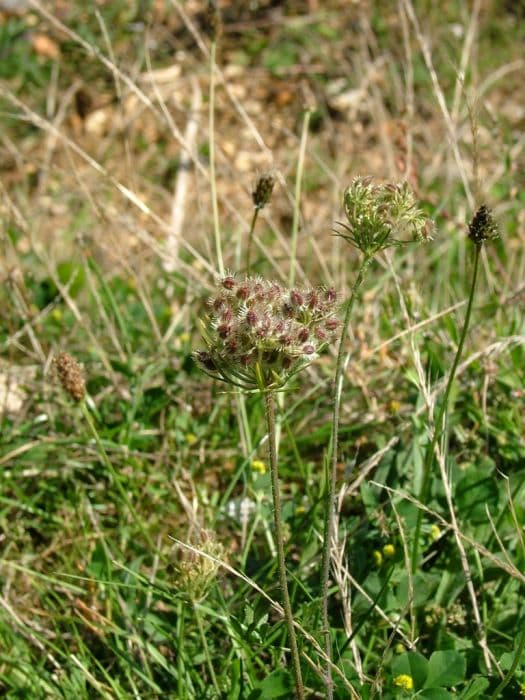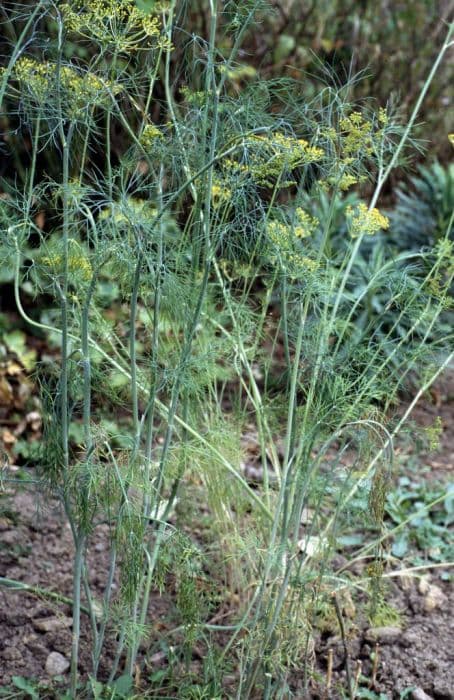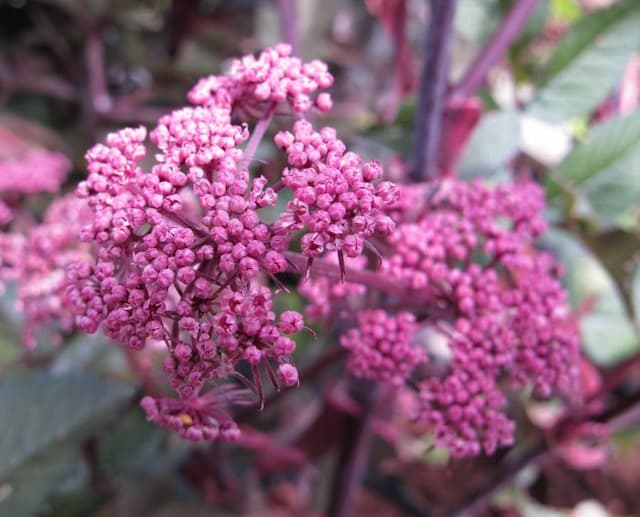Carrot Daucus carota

ABOUT
Commonly known as the wild carrot, this plant typically features a rosette of green leaves that are pinnate, with finely divided leaflets that give them a feathery appearance. Rising from the center of the leaf cluster is a slender, erect flower stalk which culminates in a flat-topped cluster of tiny flowers that are usually white. Sometimes, a single dark purple flower is found in the center of the flower head. The roots are long, conical, and typically orange in color, resembling the cultivated carrot, which is indeed a descendant of this wild species.
About this plant
 Names
NamesFamily
Apiaceae.
Synonyms
Wild Carrot, Queen Anne's Lace, Bird's Nest, Bishop's Lace, Carrot.
Common names
Carota sativa, Daucus carota subsp. sativus, Daucus gingidium, Daucus glaberrimus, Daucus hispanicus, Daucus maximus.
 Toxicity
ToxicityTo humans
Carrot (Daucus carota) is a widely known edible plant that is not toxic to humans. On the contrary, carrots are nutritious, containing various vitamins and minerals. There are no known toxic effects or symptoms associated with the ingestion of carrots for a healthy individual when consumed in typical dietary amounts. However, excessive consumption of carrots can lead to a harmless condition called carotenemia, wherein the skin takes on a yellow-orange tint due to the accumulation of beta-carotene, but this condition is not considered poisoning and is reversible.
To pets
Carrot (Daucus carota) is generally considered safe for pets, including dogs and cats, and is often used as a healthy treat. Similar to humans, there are no known toxic effects from eating carrots for pets when given in reasonable quantities. Carrots can be offered as a low-calorie snack that can also help to maintain dental health in pets due to their crunchy texture, which can help in scraping off plaque from their teeth. As with any treat, it should be given in moderation to prevent digestive upset or potential choking hazards, especially if given in large pieces or whole.
 Characteristics
CharacteristicsLife cycle
Biennials
Foliage type
Deciduous
Color of leaves
Green
Flower color
White
Height
3 feet (0.9 meters)
Spread
1 foot (0.3 meters)
Plant type
Herb
Hardiness zones
3-9
Native area
Europe and Southwestern Asia
Benefits
 General Benefits
General Benefits- Edible Root: Daucus carota, commonly known as carrot, has a nutrient-rich edible root that is high in vitamins, particularly vitamin A, essential for healthy vision and immune function.
- Culinary Uses: Carrots are versatile in the kitchen, used in a variety of dishes from salads to soups, and they can be consumed raw, cooked, or juiced, adding flavor and texture to meals.
- Dietary Fiber: Carrots provide dietary fiber which aids in maintaining a healthy digestive system.
- Low-Calorie Snack: As a low-calorie food with a satisfying crunch, carrots make an excellent snack for those looking to maintain or reduce weight.
- Soil Improvement: The deep roots of the carrot plant can help to break up soil and improve its structure, benefiting garden ecosystems.
- Natural Sweetener: The natural sweetness of carrots allows them to be used as a sweetening agent in recipes, reducing the need for added sugars.
- Bee Attractant: When allowed to flower, the carrot plant can attract beneficial insects, such as bees, to the garden, aiding in pollination.
- Farming Benefits: Carrots are a popular crop that can be relatively easy to grow and can be planted as part of a crop rotation system, helping to control pests and diseases organically.
 Medical Properties
Medical Properties- Antioxidant: Carrots contain beta-carotene, which has antioxidant properties that can help prevent free radical damage to cells.
- Vision support: Beta-carotene in carrots is converted to vitamin A in the body, which is important for maintaining healthy vision, especially night vision.
- Digestive health: The fiber in carrots can aid digestion and prevent constipation.
- Cardiovascular benefit: The high fiber content and the presence of antioxidants like beta-carotene may contribute to cardiovascular health by reducing cholesterol levels and preventing oxidative damage to heart tissues.
- Anti-cancer potential: Carrots contain various compounds, such as falcarinol, that may have anti-cancer properties, although more research is needed to confirm their effectiveness.
- Anti-inflammatory properties: Carrots have compounds that may help reduce inflammation in the body.
- Diabetes support: Carrots have a low glycemic index, which makes them suitable for people managing diabetes. They can help regulate blood sugar levels.
- Immune system support: With a good supply of vitamin C, carrots can contribute to immune system health.
 Air-purifying Qualities
Air-purifying QualitiesThis plant is not specifically known for air purifying qualities.
 Other Uses
Other Uses- Carrot seeds are used as an aromatic component in perfumes, adding a fresh, sweet dimension to fragrance compositions.
- The dried stalks of the carrot plant are sometimes used in floral arrangements as a decorative filler due to their textured and feathery appearance.
- Carrot juice can be used as a natural dye for textiles and crafting, providing a range of yellow and orange hues.
- When combined with vinegar, carrot pulp can be used to create a natural wood stain for woodworking projects.
- Carrot tops, the green foliage of the plant, are often used in culinary settings as a fresh herb, similar to parsley.
- In papermaking, carrot fibers from the pulp can be incorporated into the paper to add texture and color.
- Carrot flowers are edible and can be used as a garnish or salad addition for a sweet and slightly herbal flavor.
- Compressed carrot seed oil is sometimes used in natural paint formulations as a binding agent and for its mild preservative properties.
- The root of the carrot can also be used in animal feed, particularly for horses, providing nutritional benefits and natural sweetness.
- Carrot peelings and scraps from culinary use are often composted, playing a role in nutrient recycling and soil enrichment for gardening.
Interesting Facts
 Feng Shui
Feng ShuiThe carrot is not used in Feng Shui practice.
 Zodiac Sign Compitability
Zodiac Sign CompitabilityThe carrot is not used in astrology practice.
 Plant Symbolism
Plant Symbolism- Fertility: Daucus carota, commonly known as the wild carrot or Queen Anne's lace, is often associated with fertility and abundance. This could be due to its prolific seed production and its feathery, fertile appearance.
- Purification: Traditionally, the wild carrot has been used in medicinal concoctions meant to cleanse the body, so it symbolizes purification and detoxification.
- Protection: In folklore, it was believed that the wild carrot could ward off harmful spirits. As such, it is sometimes used in protective amulets.
 Water
WaterCarrots need consistent moisture, especially during seed germination and early growth stages. Water carrots with about one inch of water per week, ensuring the soil stays moist but not soggy. Deep watering encourages deep root growth, so it's best to water thoroughly and less frequently, rather than little and often. Adjust watering based on rainfall and check the top inch of soil for dryness before watering again. In general, you might water with roughly half a gallon per square foot every week, depending on soil type and weather conditions.
 Light
LightCarrots grow best in full sunlight, which means they need at least six hours of direct sunlight daily. The best spot for growing carrots is an area without shade from trees or buildings to ensure they receive ample sunlight throughout the day. However, in hot climates, they can tolerate some light afternoon shade to protect from extreme heat.
 Temperature
TemperatureCarrots thrive in cooler temperatures and can survive a light frost. They can germinate in soil as chilly as 35 degrees Fahrenheit and grow well in temperatures ranging between 60 to 70 degrees Fahrenheit. Carrots can survive temperatures up to 75 degrees Fahrenheit but prefer cooler conditions. The maximum temperature for growing carrots should not exceed 85 degrees Fahrenheit, as high heat can lead to poor root development.
 Pruning
PruningCarrots do not require pruning in the traditional sense. Thinning out carrot seedlings is a form of pruning and is crucial to prevent crowding, which can lead to small and misshapen roots. Thin seedlings when they are an inch tall, leaving 1-2 inches between them. The best time to thin is when the soil is moist, and carrot tops are dry to minimize disturbance and the risk of disease.
 Cleaning
CleaningNot needed
 Soil
SoilCarrot prefers a well-draining, sandy or loamy soil with a pH between 6.0 and 6.8. For the best growth, mix garden soil with compost to enrich the soil and ensure good drainage. Avoid heavy and compact soils to enable proper root development.
 Repotting
RepottingCarrots, commonly known as carrots, are typically grown as annuals and do not require repotting. They are sown directly into the garden and harvested within one growing season.
 Humidity & Misting
Humidity & MistingCarrots thrive best in moderate humidity levels; however, they are adaptable and can tolerate various humidity conditions as long as proper soil moisture is maintained.
 Suitable locations
Suitable locationsIndoor
Grow carrots in deep containers with ample light.
Outdoor
Sow in sunny spots; thin seedlings for optimal growth.
Hardiness zone
3-10 USDA
 Life cycle
Life cycleCarrot (Daucus carota) begins its life cycle as a seed, which, when sown in fertile, well-drained soil and under suitable temperature conditions, will germinate. Upon germination, it develops a small root and seed leaves (cotyledons) that push through the soil surface. As the plant grows, true leaves emerge and the root starts to thicken and store nutrients, gradually taking on the familiar shape and size of a carrot. In its first growing season, the plant focuses on vegetative growth, but if left in the ground through winter, it will enter a second year and initiate reproductive growth. In the second year, the carrot plant grows a flowering stalk that produces white or purple flowers grouped in umbels, which then result in the formation of seeds after pollination. The life cycle completes when these seeds disperse, ready to begin a new generation of carrot plants.
 Propogation
PropogationPropogation time
Spring to early summer
The common name for Daucus carota is carrot, a root vegetable widely known for its edible taproot. The most popular method of propagation for carrots is by seed. To propagate carrots by seed, the optimal time to sow is in the spring after the last frost when the soil temperatures are at least 45 degrees Fahrenheit (7 degrees Celsius). Seeds should be planted directly into well-drained, loose soil to a depth of about 1/4 to 1/2 inch (6 to 13 mm). It's important to keep the soil consistently moist but not waterlogged to encourage germination. Thinning the seedlings is necessary once they've grown, ensuring that they are spaced approximately 2 to 3 inches (5 to 7.6 cm) apart to prevent overcrowding and to allow the roots to develop properly. Germination typically occurs within two to three weeks depending on the soil temperature and conditions.









